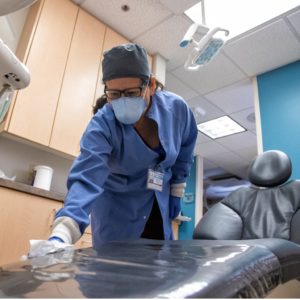Interventional Care


We notice that you are visiting us from . This site only services US-based visitors. Would you like to visit the site that is appropriate for your location?

When you think of going to the dentist for a cleaning, it rarely crosses your mind that you could leave with more than you bargained for, like an infectious disease. We often assume that the dental office has taken the necessary steps of infection control and cleaning/disinfection practices, but that is not always the case.
Now more than ever before, dental offices must be hypervigilant to ensure they are following all recommendations for cleaning and disinfection practices to help protect against COVID-19. If not, it has been shown that outbreaks can occur. For example, I live in Colorado and there were seven cases of COVID-19 linked directly to two dental offices in El Paso County in July of 2020(1). So, what should dental offices be doing daily to ensure a proper environment of care practices and disinfection of surfaces?
Not to be confused with routine surfaces that must be cleaned, many dental instruments used inside of patients’ mouths require high-level disinfection or sterilization. The difference between sterilization and disinfection is as follows according to the CDC; “Disinfection destroys most pathogenic and other microorganisms by physical or chemical means. In contrast, sterilization destroys all microorganisms, including substantial numbers of resistant bacterial spores, by heat (steam autoclave, dry heat, and unsaturated chemical vapor) or liquid chemical sterilants. Disinfection does not ensure the degree of safety associated with sterilization processes.”
Dental offices either use on-site steam sterilization cabinets or send their instruments off-site to be re-processed by experts. The instruments come back to the office nicely packaged and ready for the next patient.
The proper disinfection of the environment within a dental office is paramount, as many surfaces can become contaminated by dental sprays/spatter, contaminated dental instruments, or gloved hands(2). Healthcare providers in this space must have a clear understanding of the level of risk for such surfaces. The CDC has definitively outlined them into categories which they label as “clinical contact surfaces” or “housekeeping surfaces”, with different recommendations for cleaning and disinfection for each, and they are as follows: Clinical contact surfaces in Dental settings are at higher risk of becoming contaminated and require closer attention to the disinfection practices around them. The CDC recommends the use of surface barriers to protect, particularly for surfaces that are hard to clean and to change barriers between patients. Barriers include clear plastic wrap, bags, sheets, tubing, and plastic-backed paper or other materials impervious to moisture(3).
Surfaces not protected by such barriers must be cleaned and disinfected using an EPA-registered disinfectant with a low-level (i.e., HIV and HBV label claims) to intermediate-level (i.e., tuberculocidal claim) activity after each patient. Use an intermediate-level disinfectant if visibly contaminated with blood. The list of such higher risk surfaces includes (but is not limited to) the following:
In contrast, housekeeping surfaces are considered at lower risk for disease transmission, and so do not require as rigorous a disinfection program. According to the CDC, most housekeeping surfaces within the dental office need to be cleaned with only a detergent and water or an EPA-registered disinfectant, depending on the nature of the surface and the type and degree of contamination(3). Such surfaces include the following:
A solid dental infection control program should include clear and easy-to-follow standard operating procedures which clearly explain the steps for cleaning and disinfection, as well as any quality testing and follow-up that needs to be done. However, this is only half the battle.
Room turnover to get the next patient in as quickly as possible can be a challenge when all these things are required. Dental offices also have a plethora of disinfectants that they can choose from, but some may have misleading kill claims on the label- for example claiming to be a “one minute” when on the back it shows ten minutes for some pathogens like certain fungi. So, what should an office choose when looking for the ideal disinfectant?
Dr. William Rutala has developed a list of important things to consider when choosing a disinfectant for healthcare facilities, and dental offices are included. He believes the ideal disinfectant should include(4):
PDI provides a wide range of disinfectant wipes for use in the dental office that meets all these requirements including Super Sani-Cloth® Germicidal Disposable Wipe, featuring a fast contact time and allows for a quick room turnover, making it the ideal disinfectant for daily use in fast-paced environments that require short contact times and broad coverage of microorganisms.
References: